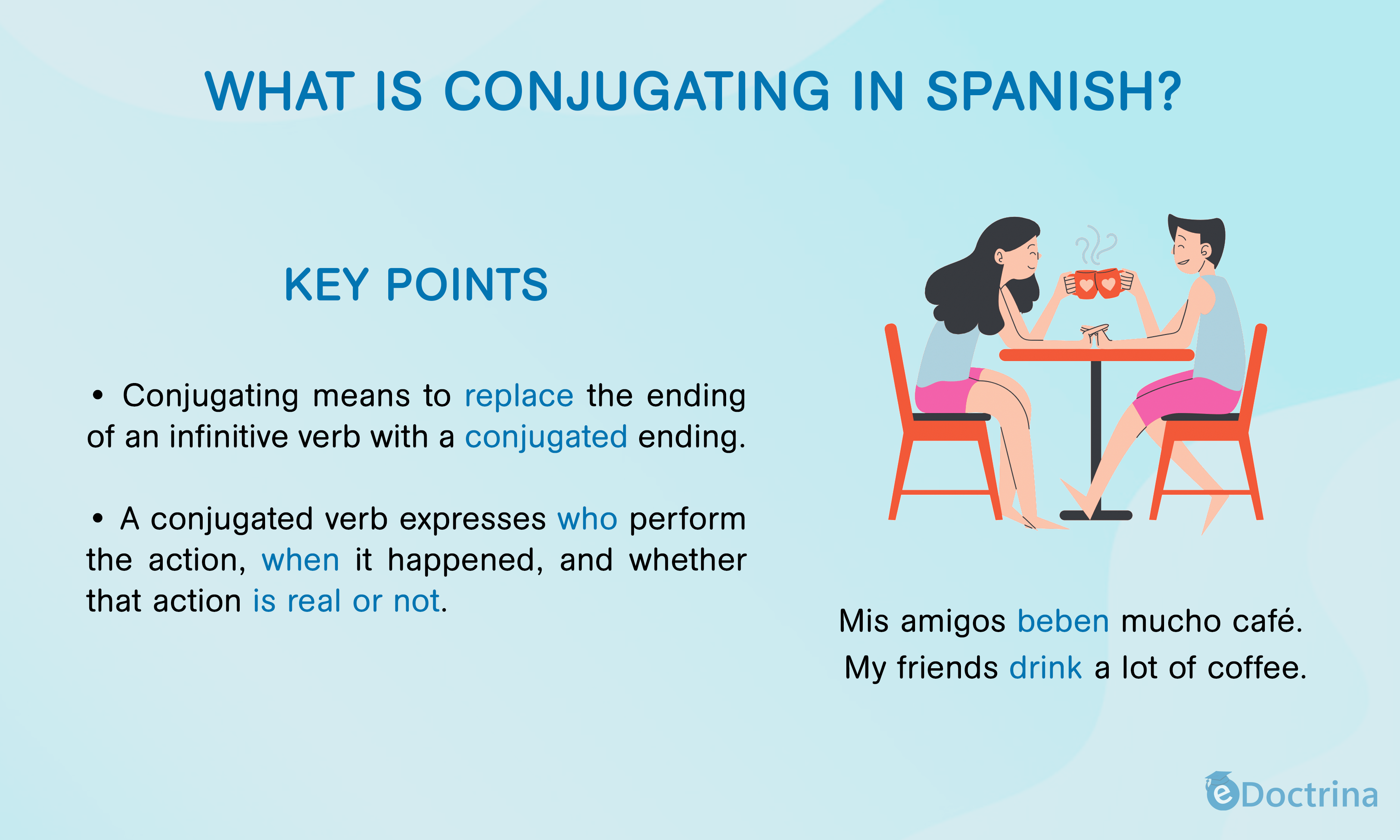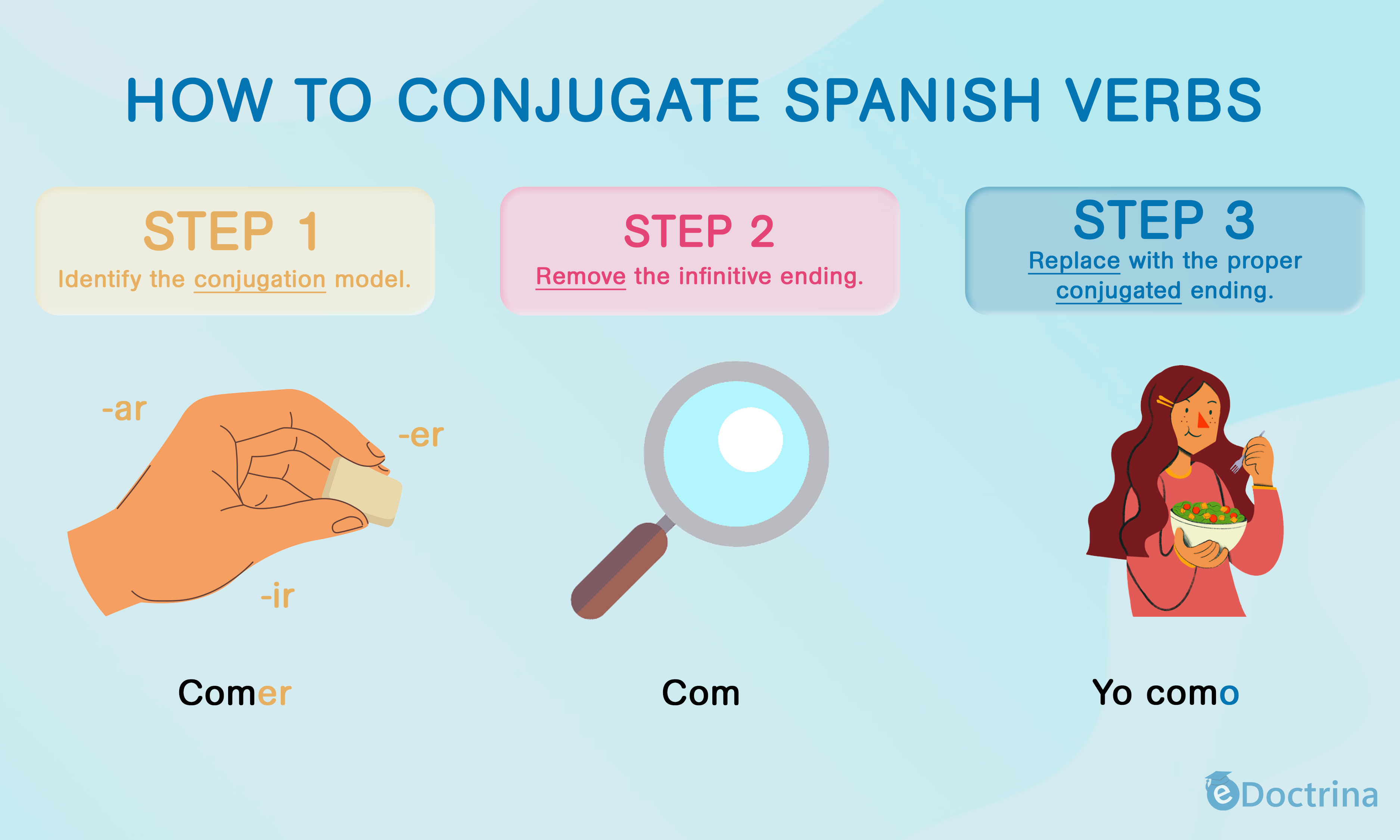Mastering verb conjugation is paramount as verbs undergo changes based on tense, mood, and person. Familiarizing yourself with the rules for conjugating verbs in Spanish is essential. In this guide, we’ll cover:
By the conclusion, you’ll grasp the fundamentals of conjugating Spanish verbs. To simplify the learning process, I’ve incorporated various examples featuring basic Spanish verbs..
Kindly observe: Spanish verbs serve as the linguistic element that articulates actions (Yo leo) or describes the state of something’s existence (La casa es azul).
Understanding Spanish Verb Conjugation: What Does it Entail?
Conjugating a verb entails altering its ending to match the subject, mood, and tense. In essence, when we conjugate a Spanish verb, we modify its ending to indicate:
- Who is performing the action (subject)
- When the action occurs (tense)
- How the action is perceived (mood)
Consider “bailar” as an example:
Yo bailo muy bien.
I dance very well.
Ellas bailaron en la fiesta.
They danced at the party.
Let’s turn our attention to example #2. In this sentence, the Spanish conjugation signifies that they carried out the action at a specific point in the past. Moreover, the verb ending also denotes that this action is presented as a factual statement (indicative mood).

As evident, a verb’s conjugations offer vital information essential for effective communication. In the following sections, you’ll delve deeper into the art of conjugating verbs in Spanish.
Kindly observe: In Spanish, nouns and adjectives undergo modifications to convey both number and gender, a concept referred to as agreement in Spanish grammar. Verbs are also subject to agreement, but unlike nouns and adjectives, verb agreement primarily concerns number rather than gender – for instance, “él” vs “ellos,” “tú” vs “ustedes,” and so on.
Do you want to learn more?
Join the e-Doctrina Spanish community and learn basic Spanish communication in a carefully graded way for beginners.
Mastering Spanish Verb Conjugation

As previously mentioned, infinitive verbs in Spanish are in their non-conjugated base form. Infinitives are identifiable by three endings:
| -AR (1st conjugation) | -ER (2nd conjugation) | -IR (3rd conjugation) |
|---|---|---|
| Cantar | Beber | Abrir |
| Dejar | Comer | Escribir |
| Hablar | Correr | Vivir |
And why is this significant? Because these infinitive endings not only attach to the verb’s root but also indicate the conjugation model (more commonly referred to as conjugation type in English) you need to follow.
Once you grasp this concept, the steps for conjugating a verb in Spanish are straightforward:
- Identify the conjugation type.
- Remove the infinitive ending to obtain the verb’s root.
- Substitute it with the appropriate conjugation ending.

Keep in mind that, unlike English, Spanish conjugation features distinct endings for each subject pronoun and tense. In essence, when selecting an ending to conjugate a verb, it’s essential to ensure it aligns with the appropriate person.
A Comparison Verbs : Regular vs Stem-Changing vs Irregular
Review this conjugation chart featuring buscar, aprender, and preferir:
| -AR | -ER | -IR | |
|---|---|---|---|
| Yo | Busco | Aprendo | Prefiero |
| Tú | Buscas | Aprendes | Prefieres |
| Él / EllaUsted | Busca | Aprende | Prefiere |
| Nosotros | Buscamos | Aprendemos | Preferimos |
| Vosotros | Buscáis | Aprendéis | Preferís |
| Ellos / EllasUstedes | Buscan | Aprenden | Prefieren |
As depicted in the table above, Spanish verbs fall into different categories. Regular verbs, such as “aprender,” maintain their root without alterations. Conversely, stem-changing verbs, like “preferir,” exhibit minor spelling adjustments to their root.
In contrast, irregular verbs in Spanish, such as “ir,” undergo changes to their root, often necessitating the use of different endings as well.
Conjugation of Reflexive Verbs in Spanish
In Spanish, conjugating a reflexive verb follows the same pattern as conjugating other verbs. The only distinction is that reflexive verbs feature the reflexive pronoun “se” in their infinitive form.
Examples include:
- Bañarse
- Ponerse
- Vestirse
This reflexive pronoun must agree with the subject. In other words, you need to adjust it to match the subject. However, as demonstrated in the examples above, these verbs also retain the -AR, -ER, and -IR endings, indicating the conjugation pattern to be followed.
For example:
Yo me baño.
I shower.
Tú te bañas.
You shower.
Nosotros nos bañamos.
We shower.
Kindly observe: In Spanish, unlike in English, subject pronouns can be omitted because a conjugated verb already indicates who performs the action.
When to Conjugate Spanish Verbs: Understanding the Rules
In Spanish, sentences containing a single verb require conjugation:
| Incorrect | Correct |
|---|---|
| Ella tener sueño. She to have sleepy. | Ella tiene sueño. She is sleepy. |
However, in sentences with an auxiliary verb, the auxiliary must be conjugated, while the second verb remains in infinitive, present participle (also known as gerund), or past participle form. For instance:
Van a comer.
They are going to eat.
¿Qué estás haciendo?
What are you doing?
No he visto esa película.
I have not seen that movie.
Essential Points
Mastering Spanish conjugation is essential for effective communication. Here are some key points to remember:
- Conjugated verbs convey who performs the action, when it occurs, and how factual (or hypothetical) nature of the activity.
- Each subject in Spanish has its own conjugation ending, allowing for the omission of subject pronouns.
- Verbs ending in -AR, -ER, and -IR belong to different conjugation models.
- The root of a verb is combined with these endings.
- To conjugate a verb in Spanish, remove the infinitive termination and add the appropriate ending to the verb’s root.
- The stem of regular verbs remains unchanged.
- Stem-changing verbs undergo minor spelling modifications in their root.
- Irregular verbs undergo significant changes in their stem and sometimes in their endings.
- The second verb in a sentence can be a gerund, past participle, or infinitive.

